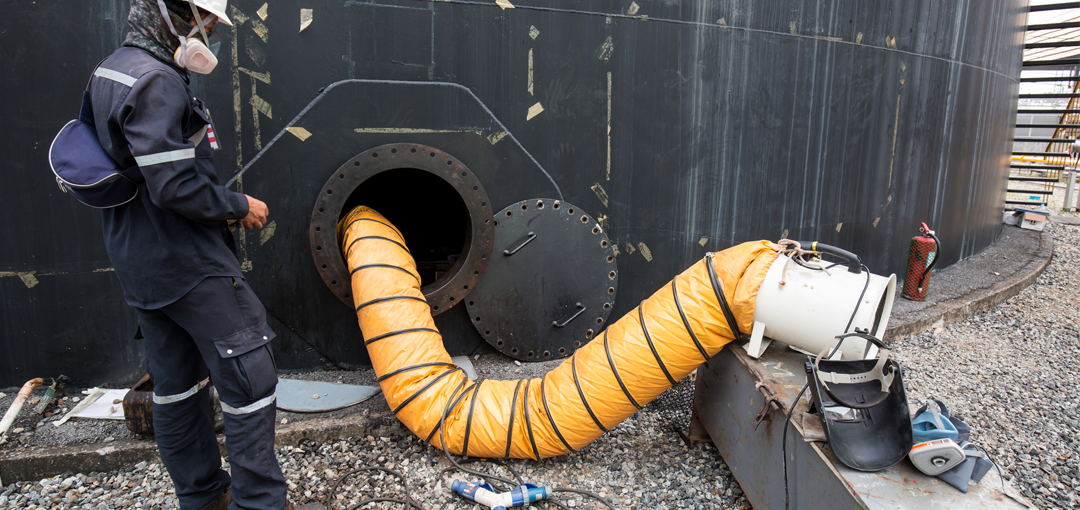How To Properly Ventilate A Confined Space
How To Properly Ventilate A Confined Space
September 4, 2023 |
Properly ventilating a confined space is an essential aspect of ensuring the safety of individuals working or entering such environments. Confined spaces, characterized by limited entry and exit points and restricted airflow, can pose serious risks due to the potential accumulation of hazardous gases, lack of oxygen, or other dangerous conditions. Whether it’s a manhole, storage tank, tunnel, or any other confined area, understanding the principles of ventilation is paramount. Let us look into the techniques, precautions, and best practices required to effectively ventilate a confined space and mitigate potential hazards.
Understanding Confined Spaces and Ventilation
Before delving into the intricacies of proper ventilation techniques, it’s of paramount importance to gain a comprehensive understanding of what precisely constitutes a confined space and why the implementation of effective ventilation strategies within these spaces is an absolute necessity. Broadly defined, a confined space is characterized by its limited openings for both entry and exit, often compounded by a deficiency in natural airflow.
This encapsulated nature can encompass a range of environments such as storage tanks, tunnels, silos, underground utility vaults, and more. Owing to the inherent constraints of these areas, they become highly susceptible to the gradual buildup of hazardous gases, potentially noxious vapors, or even perilous dust particles, all of which, if left unchecked, can swiftly escalate into life-threatening situations with far-reaching consequences.
The Importance of Proper Ventilation
Properly ventilating a confined space serves two primary purposes: ensuring an adequate supply of breathable air and preventing the buildup of hazardous substances. Insufficient oxygen levels can lead to asphyxiation, while the accumulation of gases like hydrogen sulfide or methane can result in explosions or poisoning. Effective ventilation helps maintain a safe environment by providing a continuous flow of fresh air, removing contaminants, and preventing the formation of dangerous concentrations.
Techniques for Ventilating Confined Spaces
Ventilating a confined space requires careful planning and the use of appropriate techniques. One common method is natural ventilation, which relies on the natural movement of air. However, this might not be sufficient in many cases, especially if the confined space is deep or lacks adequate openings for airflow. Mechanical ventilation, involving the use of fans or blowers, is often more reliable. This technique can either involve blowing fresh air into the space or extracting contaminated air, depending on the specific situation.
Precautions and Safety Measures
Before initiating any ventilation process in a confined space, it’s imperative to take various precautions to ensure the safety of everyone involved. Conduct a thorough assessment of the space to identify potential hazards, such as toxic gases, flammable materials, or poor air quality. Adequate training for personnel involved in the ventilation process is essential, as they should be well-versed in using ventilation equipment, emergency procedures, and the use of personal protective equipment (PPE) such as respirators.
Establishing an Effective Ventilation Plan
Creating a well-thought-out ventilation plan is a critical step in ensuring the safety of confined space operations. Start by evaluating the specific characteristics of the space, including its size, shape, and potential hazards. Determine the appropriate type and size of ventilation equipment needed for the job. The plan should also outline the ventilation duration required to achieve safe conditions within the confined space. Regular monitoring using gas detectors or air quality meters is essential during the ventilation process to ensure that hazardous conditions are being effectively mitigated.
Continuous Monitoring and Emergency Preparedness
Ventilation is an ongoing process that requires continuous monitoring to maintain safe conditions. Gas concentrations, oxygen levels, and air quality should be regularly assessed to ensure that the ventilation system is functioning as intended. In the event of any unexpected changes or malfunctions in the ventilation equipment, it’s crucial to have well-defined emergency procedures in place. Personnel should be trained to respond swiftly and appropriately to any emergencies, including evacuation protocols and first aid measures.
Properly ventilating a confined space is not just a regulatory requirement; it’s a fundamental aspect of safeguarding lives and preventing accidents. Understanding the risks associated with confined spaces and adopting effective ventilation techniques can significantly reduce the chances of hazardous situations arising. By following safety protocols, implementing ventilation plans, and staying vigilant throughout the process, individuals can work confidently and safely in confined spaces while minimizing potential risks. Remember, the air we breathe within these spaces can make all the difference between a successful operation and a tragic incident. So, whether you’re a worker, supervisor, or safety officer, prioritizing proper ventilation is a shared responsibility that should never be underestimated. Ultimately, a commitment to thorough planning, continuous monitoring, rapid response, and a culture of safety will ensure that confined spaces remain conducive to both productivity and well-being.
